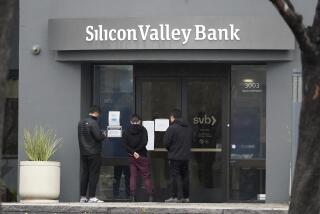Downey Savings Is Suitor for Thrift : Negotiations Continuing for Insolvent Butterfield S
- Share via
Downey Savings & Loan in Costa Mesa is negotiating with federal regulators to buy the insolvent Butterfield Savings & Loan, a move that would rid the industry of one of its sicker savings institutions.
Regulators rejected an initial offer Downey made for the Santa Ana thrift earlier this year, but negotiations have continued to the point where both sides are “closer to reaching a meeting of the minds,” Downey President Maurice L. McAlister said in an interview.
McAlister said he believes his institution would be an ideal S&L; to take over Butterfield because Downey knows its problems, has the expertise to handle them and can use the tax benefits amassed by the money-losing Butterfield.
A spokesman for the Federal Savings and Loan Insurance Corp., the receiver for Butterfield, declined to confirm or deny the negotiations.
Managed Butterfield
Butterfield lost $15 million in the first quarter this year and more than $80 million since August, 1985, when regulators declared it insolvent, seized it and ousted its president, Donald W. Endresen, and other executives. At the end of March, Butterfield’s $700.7 million in liabilities exceeded its assets by $122.8 million.
It was an executive team from Downey that regulators hired to manage Butterfield after the federal takeover as regulators sought alternatives to liquidating the S&L.;
The management contract expired at the end of December, 1986, but Anne Bacon, a senior executive vice president heading the team, quit Downey to take over as Butterfield’s president.
During 1987, Downey had sporadic talks with regulators about acquiring Butterfield, said John Dennis, a Downey spokesman.
However, about three months ago, McAlister said, Downey sent accountants into Butterfield to review its assets and presented a formal proposal to buy the troubled S&L.; Regulators rejected the offer but have continued active talks with Downey executives, he said.
Points of Contention
“What’s attractive is that, number one, we were in there managing, so we’re familiar with the problems and can provide a benefit, as a public service, to help cure the problem,” McAlister said. “Number two, we have good earnings, so we can benefit from the tax benefits Butterfield has.”
He said negotiating points still in contention include the amount of money FSLIC would provide to Downey to take over Butterfield’s high-interest deposits and whether Downey would be able to take full advantage of Butterfield’s tax benefits. Typically, FSLIC likes to receive compensation in return for an insolvent thrift’s tax benefits.
With more than $3.1 billion in assets at the end of the year and net income of $33.2 million last year, Downey was the ninth-best performing company and the top S&L; in the state last year, according to a recent Times survey of the state’s publicly held companies.
It grew partly as a result of its expertise in real estate investments, the very activity that caused Butterfield, which was founded by Endresen in 1981, to drop more than $40 million before the takeover.
Under Endresen, Butterfield grew rapidly to an $830-million thrift with assets that included such untraditional projects as Wendy’s and Love’s restaurants, interests in real estate limited partnerships and rundown apartments across the nation that he suspected had nowhere to go but up in value.
Better Loan Quality
Under Bacon, Butterfield has shed itself of the restaurants, much of the overvalued properties and 10 of its 11 subsidiaries or divisions that were engaged in more unusual activities, such as insurance and property management businesses. In the process, the number of employees has been cut from 1,200 to 145, she said.
But Butterfield has been making good-quality loans on single-family homes, she said, in an effort to offset the continuing losses caused by the S&L;’s growing deficit.
Endresen used high interest rates to attract big depositors, and Bacon has had to continue the policy to service the S&L; debts.
Bert Ely, an Alexandria, Va., industry consultant, said Butterfield’s reliance on large deposits has given it an average deposit balance of more than $53,000, the fourth highest in the nation at the end of last year. The industry average, he said, is $7,500 per account.
More to Read
Inside the business of entertainment
The Wide Shot brings you news, analysis and insights on everything from streaming wars to production — and what it all means for the future.
You may occasionally receive promotional content from the Los Angeles Times.








